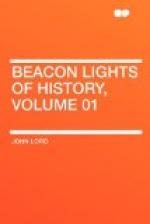But it is the work which he represents—and still more comprehensively Art itself in the ancient world—to which I would call your attention, especially the expression of Art in buildings, in statues, and in pictures.
“Art” is itself a very great word, and means many things; it is applied to style in writing, to musical compositions, and even to effective eloquence, as well as to architecture, sculpture, and painting. We speak of music as artistic,—and not foolishly; of an artistic poet, or an artistic writer like Voltaire or Macaulay; of an artistic preacher,—by which we mean that each and all move the sensibilities and souls and minds of men by adherence to certain harmonies which accord with fixed ideas of grace, beauty, and dignity. Eternal ideas which the mind conceives are the foundation of Art, as they are of Philosophy. Art claims to be creative, and is in a certain sense inspired, like the genius of a poet. However material the creation, the spirit which gives beauty to it is of the mind and soul. Imagination is tasked to its utmost stretch to portray sentiments and passions in the way that makes the deepest impression. The marble bust becomes animated, and even the temple consecrated to the deity becomes religious, in proportion as these suggest the ideas and sentiments which kindle the soul to admiration and awe. These feelings belong to every one by nature, and are most powerful when most felicitously called out by the magic of the master, who requires time and labor to perfect his skill. Art is therefore popular, and appeals to every one, but to those most who live in the great ideas on which it is based. The peasant stands awe-struck before the majestic magnitude of a cathedral; the man of culture is roused to enthusiasm by the contemplation of its grand proportions, or graceful outlines, or bewitching details, because he sees in them the realization of his ideas of beauty, grace, and majesty, which shine forever in unutterable glory,—indestructible ideas which survive all thrones and empires, and even civilizations.




